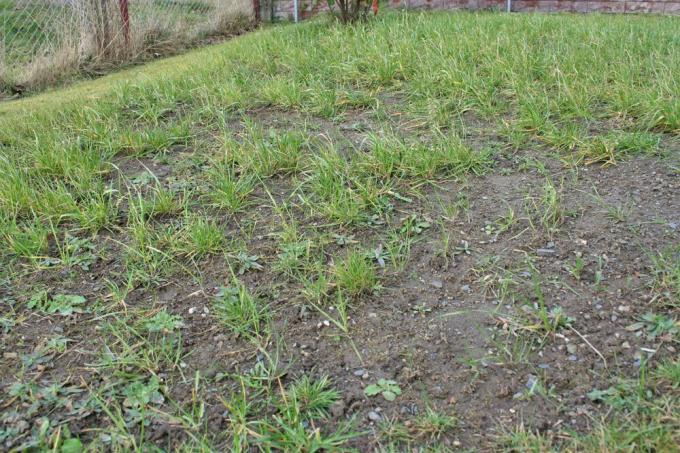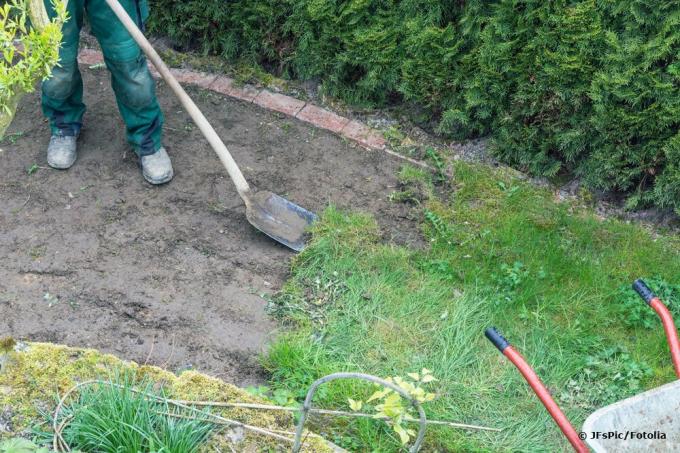
table of contents
- Possibilities for lawn renovation
- Digging up step by step
- Best time in autumn
- Sow right
- Use of a tiller
Over the years one can race become a bit unsightly. In addition, poor care can also contribute to this. There are different options for renewing the lawn. We would like to introduce one of them to you.
Possibilities for lawn renovation
Not only moss, but also bare spots or poor growth of the grass plants can make a lawn in the garden appear quite unsightly. Sometimes it is sufficient to reseed or remove moss areas by scarifying. However, these measures may not always help to make the lawn shine a lush green again. Then all that remains is to create a new lawn.

There are different options:
- dig up the area
- peeling off the lawn or
- cover
The most effective way to do this is to dig up the lawn, even if it requires a lot of muscle strength and sweat will flow. The advantages of this method are that all parts of the plants and roots above ground remain in the ground. These rot there and thus generate new nutrients. However, the microorganisms in the ground are also disturbed when digging up, but not as persistently as when the lawn is completely removed. With this method it is important that all weeds standing on the surface are brought deep into the ground. Otherwise these can germinate quickly and the area is completely covered with them.
Tip: In the case of larger areas to be worked on, the use of a motor hoe often proves to be effective.
Digging up step by step
When creating a new lawn by digging up the old one, there are a few things to consider. Thorough preparation and implementation are the be-all and end-all. Ultimately, you decide on subsequent success. It shouldn't just be dug out of it. We will show you step by step how to dig up the old lawn and then further process the area in order to obtain a beautiful new lawn. However, some patience is required. Before the actual work begins, it is advisable to mow high lawns to a short stalk height. This makes the digging work much easier. Then you can start:

- Soil should be dry
- Loosen the sod a few centimeters deep with a spade
- remove horizontally from the floor
- Store on compost heap with roots up
- thereby preventing the spread of weeds
- Fill the ground with a five-centimeter-high layer of sand
- ideally washed, fine-grain sand
- Grain size between 0 and 2 mm is ideal
- excellent low-lime quartz sand or simple play sand
- then dig up spade deep
Note: Storing the sods with the roots up on the compost helps them to rot faster. Organic materials such as kitchen waste or leaves can also be applied between the individual layers.
After the ground has been broken up to create a new lawn, the roughest work is already done. However, there is still a lot to be done:
- Slightly crumble the earth with a digging fork
- larger clods of earth break apart
- remove all stones, roots or other objects
- Free the ground 15 cm deep
- Upgrade the earth a little
- mix in some sand and large quantities of ripe compost
- Smoothing of the floor after a few days
- Using a lawn roller
- If necessary, roll the floor smooth several times in the case of large bumps

Tip: A lawn roller must be filled with water to be of the appropriate weight. Alternatively, a long wooden board or a wooden pallet can be used for rolling. These are pulled evenly on a rope in tracks across the earth's surface.
Best time in autumn
Before the lawn can be sown, the cultivated soil must settle. Usually a period of at least three to four weeks is set for this, then the soil is compacted and there are no more cavities. In any case, it would be an advantage if the soil was tilled in autumn. During the winter months, the ground can then "stand", in other words, the earth can settle in peace. Further advantages would be:
- still existing grass plants are killed by frost
- and also of weeds
- Prevention of possible unevenness in future lawns
In early spring it is then necessary to level out all existing unevenness again and level the surface repeatedly. Of course, the soil can also be tilled in early spring. However, the soil must then be given time to set.
Tip: It is easy to test whether the soil is ready for sowing by stepping on the area with one foot. For this, however, shoes with a flat sole should be worn. Should the shoe print then not be deeper than an inch, you can start sowing.
Sow right
After the floor to create a new one Lawn has been processed, only sowing has to be done. Here, too, there are a few things to consider so that it turns green in the end.

- Selection of a suitable lawn mix such as shadow lawns, play lawns, etc.
- Prepare the seedbed
- loosen the surface again a little
- then roll lightly
- Floor temperature must be at least 10 ° C
- Temperature important for germination
- Application of phosphorus fertilizer in the longitudinal direction of the area
- Spreading the seeds in the transverse direction
- promotes better growth
- best use of a spreader
- Spreading must be seamless and even
- then work the seeds lightly into the soil with a rake
- no deeper than 0.5 cm
- Lawn is a source of light
- Roll lightly for better ground contact
- not too tight
- keep the surface moist for four weeks
- possibly use of lawn sprinklers
- Watering up to five times a day for 10 minutes each time
- Avoid puddles and rivulets
- application of slow release fertilizer after six weeks
The first lawn cut after creating the new lawn should be made when the stalk is eight to ten centimeters high. The lawn should not be cut back more than five centimeters. Excessive loads on the lawn should also be avoided in the first year.
Tip: Before creating a new lawn, it is advisable to carry out a soil analysis. For this purpose, soil samples are taken from 10 to 15 different places and then mixed thoroughly. The examination takes place in the laboratory and information is given regarding the type of soil, the pH value, humus and nutrient content, as well as fertilizer recommendations.
Use of a tiller
A few words briefly about the use of a cultivator for cultivating the soil. There are different models in terms of size, weight and also the drive. Smaller hoes run on electricity and larger ones run on gasoline. In principle there are two types, namely tillers with a hoe spur or with a cleaver. With these the digging depth can be adjusted individually. Working with a tiller is of course not as sweaty as digging up by hand. The handling is relatively easy:

- no removal of the old lawn necessary
- Simply move the hoe over the appropriate surface
- always in straight rows
- loosens soil deeply
- but no reversal of the layers of the earth
- Lawn plants get deep into the earth
- there rotting and supply of new nutrients
However, it turns out to be disadvantageous that extraordinarily stubborn weeds such as couch grass, Field horsetail or groundweed are not removed, but get deep into the ground and there be distributed. It can happen if you wait too long before sowing that these weeds will spread over the area.
Note: When using a tiller, there is an increased impact on the health of the soil. The necessary microorganisms in the soil get deep into the deepest layers of the earth. It will take a longer period of time until the equilibrium is restored.



